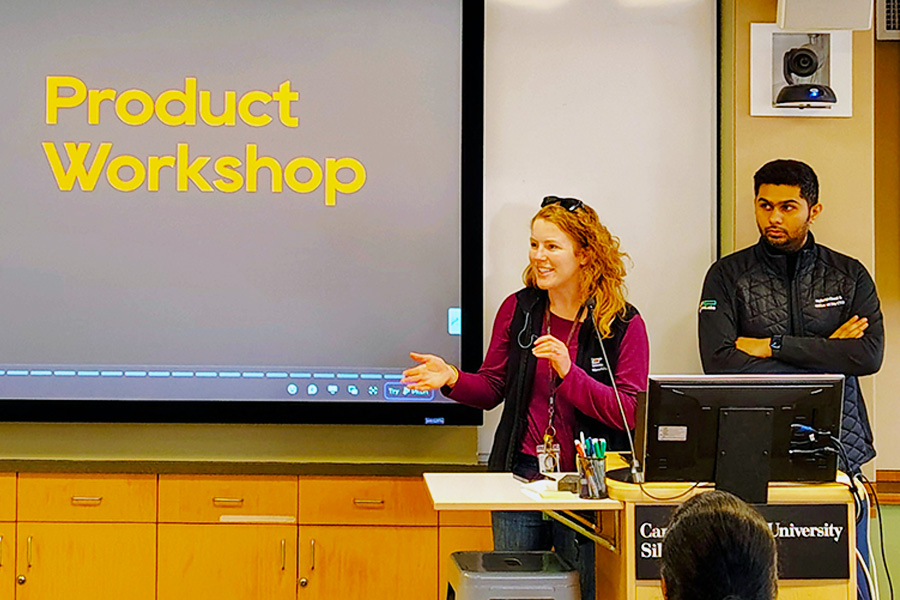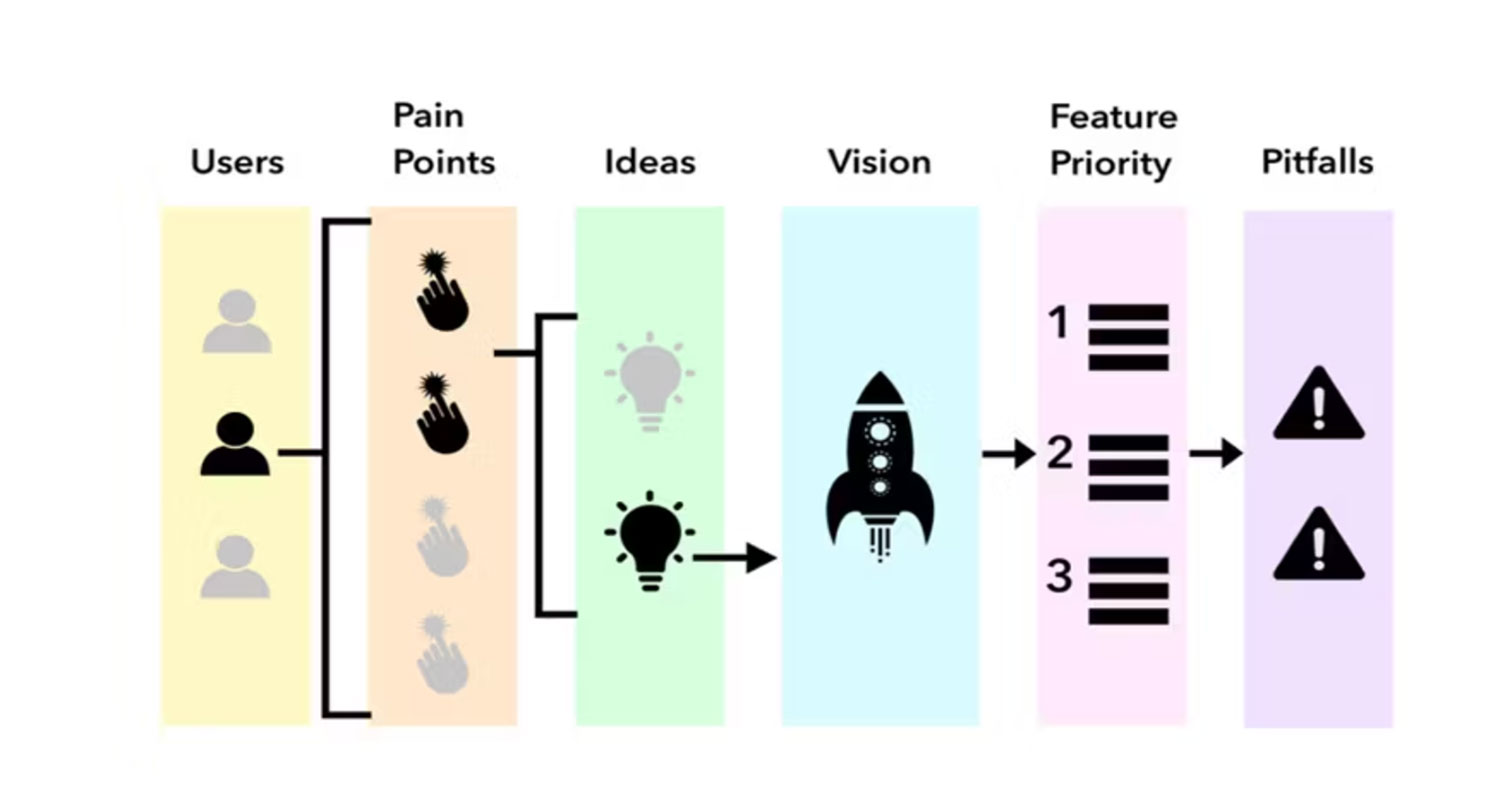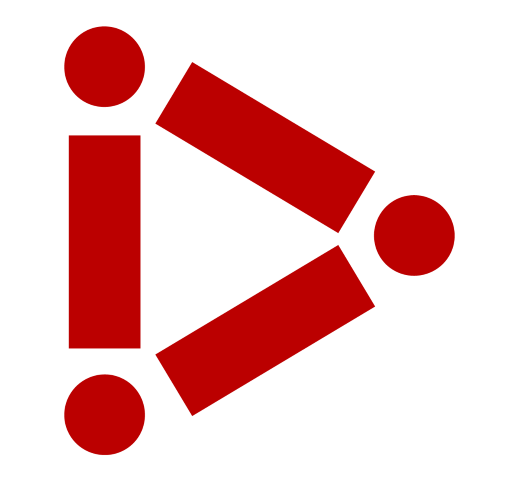
Cracking the PM Interview: Product Insights from Areeb Sanadi
The Interview Is the Product—You’re the Builder
By Phil Geist

“Interviews aren’t about perfect answers. They’re about how you think, how you communicate, and how you build a conversation.”
Areeb Sanadi (MSSM ’22)
Product Manager, Microsoft
Areeb Sanadi’s path to product management started with a Computer Science engineering degree with couple of years at a cybersecurity startup and close to three years at VMware. Wanting to broaden his impact, he joined the Master of Science in Software Management (MSSM) program at Carnegie Mellon Silicon Valley, graduating in December 2022. Post-CMU, Areeb currently works as a product manager at Microsoft in the Experiences and Devices AI division.
In early 2025, he returned to the CMU-SV campus to lead a product workshop—and opened with a simple but powerful question:
“How do we crack our interviews?”
Key Takeaways from Product Management Interview Prep
Interviews shape careers—and what separates great product managers from the rest often comes down to one thing: how they show up in interviews. Areeb emphasizes on the importance of building structure in thoughts and leveraging mock interviews, especially for later rounds, where communication and structured thinking matter most.
Mock interviews help you refine your responses and build confidence.
He also suggests exploring how others prepare for interviews, learning from common frameworks, and using platforms like YouTube and PMExercises.com, to practice real scenarios.
Strong Start: Nail the Introduction
One of the most overlooked aspects of a product manager interview is the introduction and the first two minutes can set the tone and can showcase impact and leave a lasting impression. Areeb urges candidates to treat intros as a strategic pitch while keeping introductions crisp, structured, and under two minutes—covering education, career highlights, and a personal detail to humanize the story. Keep iterating and tinkering your introduction by changing and chopping your story.
“Studies show 60% of hiring decisions are made in the first 10 minutes.”
Tailoring your introduction to meet the interviewer’s expectations can set the tone for the entire conversation. “Put yourself in their shoes,” Areeb advises. “The best interviews feel like genuine conversations. When the interviewer feels seen and understood, it leaves a lasting impression.” He recommends researching the company’s mission, values, and recent initiatives so your responses reflect a clear alignment with the organization’s culture and priorities.
Equally important is how you deliver your message. Areeb emphasizes that confident, steady communication—with a natural tone and smooth storytelling—can elevate your presence and leave a strong, memorable impact.
Answering Open-Ended Questions with Confidence
Product management interviews often include open-ended questions like “Tell me about yourself” or “How do you approach ambiguity?” These aren’t designed to elicit perfect, rehearsed answers. Instead, they give candidates the chance to demonstrate how they think, solve problems, and navigate the complexities of a fast-moving product environment.
“There’s no single right answer,” Areeb reassures. “Interviewers are looking at how you approach the problem—how you structure your thinking, explain your reasoning, and communicate a clear path forward.” Ultimately, they’re assessing whether you have the curiosity, resilience, and motivation to thrive—and stay—in the role.
“It’s about showing how you break down a problem, not just solving it.”
Behavioral - Use Personal Examples
Authenticity stands out - Personal stories resonate more than abstract theory. Sharing real experiences—from launching a product to navigating a team challenge—brings your thinking to life and makes your answers memorable.Behavioral - Prepare of the Unexpected
While you can’t predict every interview question, you can anticipate common themes by researching the company’s industry, products, and challenges. Areeb encourages candidates to prepare for the unexpected and respond in a natural, conversational tone—avoiding overly rehearsed answers. “It’s not about reciting a perfect script,” he says.“It’s about showing how you think on your feet.”When faced with a product question, don’t rush. Areeb suggests taking a moment to gather your thoughts. “Say something like, ‘Do you mind if I take a moment to think about this deeply?’—it signals thoughtfulness, not hesitation.”
Product Sense - Demonstrate Vision Alignment and Strategy
While talking about product vision, it isn’t just about solving today’s problem—it’s about imagining future opportunities. Areeb suggests:
- Define your target users clearly.
- Align ideas with the company’s mission and trends.
- Share multiple ideas, then choose one to show structured decision-making.
Great PMs think big, go wide, and get creative.
Show how your solution fits the bigger picture and unlocks future opportunities. That forward-looking mindset is what sets standout candidates apart.
Product Sense - Focus on Customer Pain Points
During product case studies or product sense/design questions jumping ahead is a common misstep. Areeb encourages candidates to begin with empathy: “Before jumping into solutions, take time to understand the customer’s pain points and why they matter.”
Ground your response in meaningful outcomes like engagement, adoption, or revenue. Then build from there—think creatively, challenge assumptions, and avoid mimicking existing solutions. Original thinking stands out more than a polished feature list.
Areeb also advises aligning your ideas with the company’s mission and current market trends. For example, referencing recent AI innovations at an AI-focused company shows strategic awareness.
To take it further, present a few distinct solutions and explain your reasoning. “Offer three options, then walk through why you’d choose one,” he says. It’s a clear way to demonstrate creativity, structure, and confident decision-making—all essential traits in a great product manager.
Product Sense - Prioritize Like a Pro
Leverage frameworks to show structured thinking wherever you can. A lot of these are thought in the CMU coursework and one such example would be the use of a frameworks like RICE (Reach, Impact, Confidence, Effort) to prioritize. These help in backing your decisions with data, prioritizing trade-offs, and showing how you arrived at your recommendations. More importantly, it demonstrates that you can think strategically, make tough calls, and operate independently — delivering clear, thoughtful priorities independently.
Product Sense - Address Trade-offs and Risks
It’s just as important to address what won’t work as it is to pitch what will. Take time to talk through any assumptions you’ve made and the potential pitfalls or consequences those assumptions might bring. Being upfront about risks, limitations, or areas of uncertainty shows self-awareness, strategic foresight, and a willingness to tackle challenges head-on — all qualities product teams value in a collaborator.

Bringing It All Together: Your Story, Strategy, and Fit
Interviewers want to understand who you are—not just as a product manager, but as a person. They’re evaluating how well you align with the company’s values and where you can be most impactful. Strong interviews blend clear thinking, empathy, and strategic vision.
Behavioural questions test soft skills like conflict resolution, ambiguity management, and collaboration. Use instances that reflect your values, decision-making style, and adaptability. Let conversations be conversational—but structured.
Interviewers may also introduce company-relevant product scenarios to assess your customer focus and relatability. Let them guide the conversation, but be ready to navigate toward product strategy, market fit, or growth planning when appropriate.
Think like a strategist—use real-world tools like cost-benefit thinking or profitability insights (à la Shark Tank) to stand out. Ultimately, strong interviews blend clear thinking, empathy, and strategic vision.
Interviewers are looking for PMs who can build clarity from chaos—and do it with intention.
Bonus TIP - Learn more about your panel and interviewing team
Whenever possible, take time to learn about your panel. Look for shared interests or recent wok—perhaps they’ve published articles on AI, supported mentorship programs, or led community initiatives. Showing alignment and shared interests during your conversation can create a natural connection and show that you’ve done your homework about the team, product and company.
Finding common ground early can shift the interview from formal to conversational, helping you stand out as a thoughtful and well-prepared candidate.
Bonus TIP - Take a Moment Before You Answer
At times you can feel overwhelmed and this happens, don’t feel pressured to answer immediately. Areeb recommends taking 30 seconds to a minute to pause and reflect. “You can say something like, ‘Do you mind if I take a moment to think about this deeply?’—it shows you’re thoughtful, not unsure,” he explains.
Use that time to:
- Ask clarifying questions
- Jot down your initial thoughts
- Break the question into manageable parts
- Understand the deeper “what” and “why” behind the problem
Pausing before you respond signals that you approach problems with care and structure.
Q&A: Product Thinking with Areeb Sanadi
iii: You’ve said interviews are more about how you think than getting the “right” answer. How do you evaluate strong product thinking in candidates?
Areeb: I look for clarity in problem framing, structured thinking, and the ability to weigh trade-offs. A great candidate can define a user, articulate pain points, and explore multiple solutions before narrowing in on the one with the most meaningful impact.
iii: What are some common mistakes during the introduction?
Areeb: Candidates often ramble or try to impress too much. Keep it tight: who you are, what you've done, and why you’re here. Make it crisp, concise and personal but relevant.
iii: Can you share a mock interview experience that improved your performance?
Areeb: During one mock, I realized I was over-relying on jargon. Feedback helped me simplify my language and structure. That made my actual interviews feel like real conversations.
iii: How do you balance preparation with spontaneity?
Areeb: Know your key stories and frameworks, but don’t memorize. Understand the what and why behind your answers so you can stay flexible and respond naturally in the moment.
iii: How should someone structure their introduction?
Areeb: There’s no one-size-fits-all formula, since every journey is unique. But a good place to start is with your story—who you are, how you got here, and the impact you’ve made along the way. Open with a narrative that reflects your identity and trajectory. The goal is to spark curiosity and set the stage for a deeper, more meaningful conversation.
iii: How can someone test their intro before interviews?
Areeb: Share it with peers, mentors, or in mock interviews. Watch how people react. Do they lean in or zone out? The best intros invite curiosity. Refine based on what lands.
iii: What’s your thought process when you pause before answering?
Areeb: I visualize the problem space and sketch it mentally. I break it down into segments—users, goals, constraints—and decide where to go deep. That pause helps me respond with intention, not instinct.
iii: What role does storytelling play in your daily work?
Areeb: Huge – it’s everything. As PMs, we’re constantly aligning teams. Storytelling builds trust, creates shared understanding, and drives urgency and momentum.
iii: How do you turn an interview into a conversation?
Areeb: Listen actively. Ask clarifying questions. Mirror the interviewer’s energy. It’s not just Q&A—it’s about building rapport and mutual curiosity.
iii: Your “chopping and chopping” analogy for refining ideas really resonated. What’s your revision process?
Areeb: I start messy, then cut about 60%. I read it aloud. If it doesn’t feel clear or honest, I rewrite. Clarity is kindness—to your audience and your ideas.
iii: Can you share a moment where your product vision expanded significantly?
Areeb: I was working on an internal tool designed to improve task efficiency. But after digging deeper into user feedback, I realized the bigger opportunity was enabling collaboration across previously siloed teams. That shift transformed the tool from a tactical solution into a strategic platform. It taught me to always zoom out and ask: “What’s the larger ecosystem this product lives in—and what ripple effects could we unlock?”
